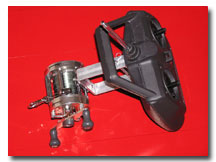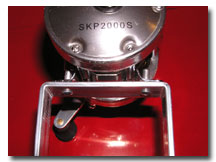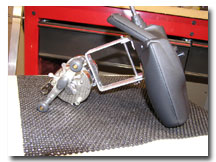How-to Article ...by Rudy Hilado
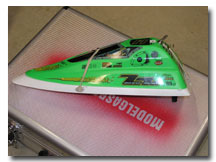
A fun way to retrieve your larger boat at the pond!
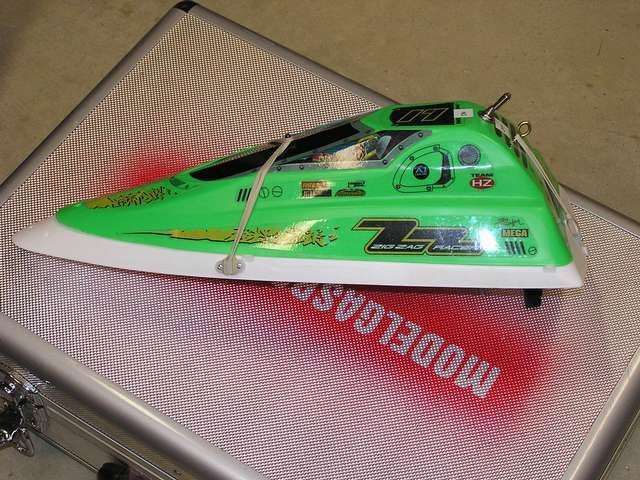 It's
happened to all gas model boaters at one time or another. Your boat stalls out
in the middle of the pond. Not everyone has the luxury of a full sized retrieve
boat, so those of us less fortunate are left to find other means of retrieval.
Short of swimming for the boat (which should never be done!) other techniques
have been developed for getting the boat safely back to the shore.
It's
happened to all gas model boaters at one time or another. Your boat stalls out
in the middle of the pond. Not everyone has the luxury of a full sized retrieve
boat, so those of us less fortunate are left to find other means of retrieval.
Short of swimming for the boat (which should never be done!) other techniques
have been developed for getting the boat safely back to the shore.
Probably one of the most common methods of boat retrieval is the "tennis ball on the fishing pole". The primary drawback to this method is accuracy, especially if the boat is really far from the shore. You can easily make dozens of casts to get the ball on the boat, and you hope that it will hook onto something so you can reel it back in. In order to improve accuracy, this technique can be modified by hand throwing the ball instead of casting it. But usually by the time the boat is back on the show, your arm is too sore to pick it up!
Another method that has been tried is to use an electric boat to drive out to the stalled boat and hook onto it or push back it to the shore. It's a fun way to retrieve dead boats, but usually the limiting factor is the battery life of the boat, and the ability of the boat to bring the stalled boat back to the shore; it's often a slow and tedious process.
So what's
the answer? Merge both techniques and create the ultimate boat retrieval
system!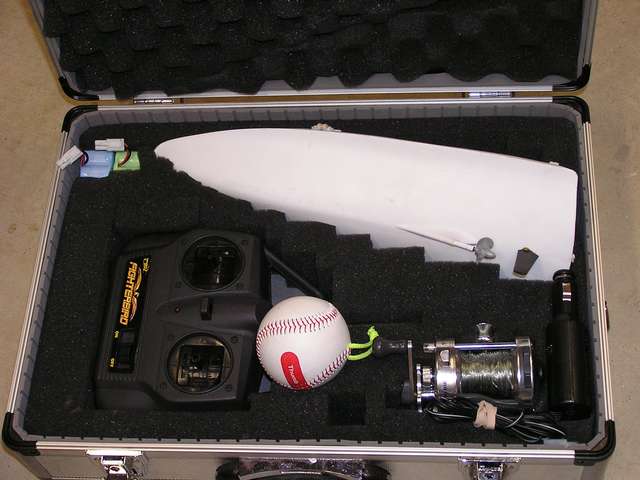 Accuracy is assured by using a electric boat to go out to the stalled gas boat,
and having the boat tethered allows you to bring both boats back to the shore in
a short amount of time.
Accuracy is assured by using a electric boat to go out to the stalled gas boat,
and having the boat tethered allows you to bring both boats back to the shore in
a short amount of time.
The system works by attaching heavy duty fishing line to the back of the electric boat. You then drive the electric boat out to the stalled boat and do a circle around it and stop the boat. Then start winding on the fishing reel. The fishing line will catch on the rudder, prop, or other hardware hanging off the boat, and both boats will be pulled back to the shore. If the fishing line slips off, just start up the electric boat again and circle around once more.
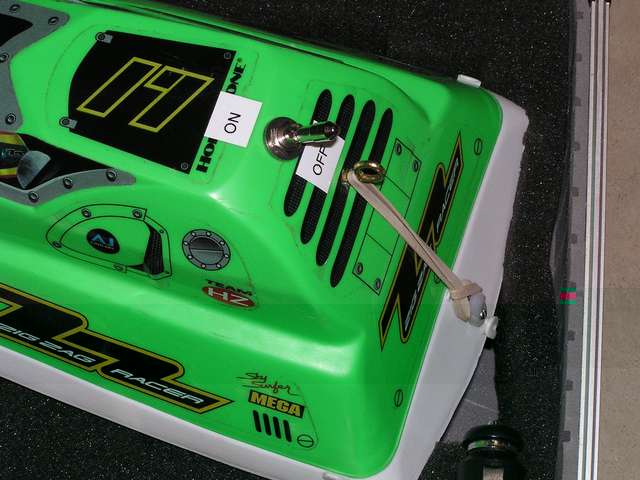 This
technique saves the batteries since they are only used to send the retrieve boat
out to the stalled boat. With a large fishing reel, it is possible to quickly
retrieve boats relatively far from shore. And since the retrieve boat is always
tethered to the shore, it is unlikely that you will lose the boat if something
goes wrong (out of radio range or the batteries dying).
This
technique saves the batteries since they are only used to send the retrieve boat
out to the stalled boat. With a large fishing reel, it is possible to quickly
retrieve boats relatively far from shore. And since the retrieve boat is always
tethered to the shore, it is unlikely that you will lose the boat if something
goes wrong (out of radio range or the batteries dying).
I've found the best boat to use as a retrieve boat is the Hobby Zone Zig Zag boat. It's small yet very fast on the water, zipping along at 10-12 mph. It is also water tight and self-righting so if it gets flipped upside down, it turns itself over so you can keep going. Additionally, it is very inexpensive, retailing for $80, complete with radio and batteries.
I've made a few modifications to the stock Zig Zag to make it work better as a retrieve boat. I've added an ON/OFF switch on the outside of the boat, and I've added rubber band latches to the outside, which holds the top on more securely and it is easier to open up and swap out the battery when necessary.
Another
benefit of using a small electric boat is you can fit the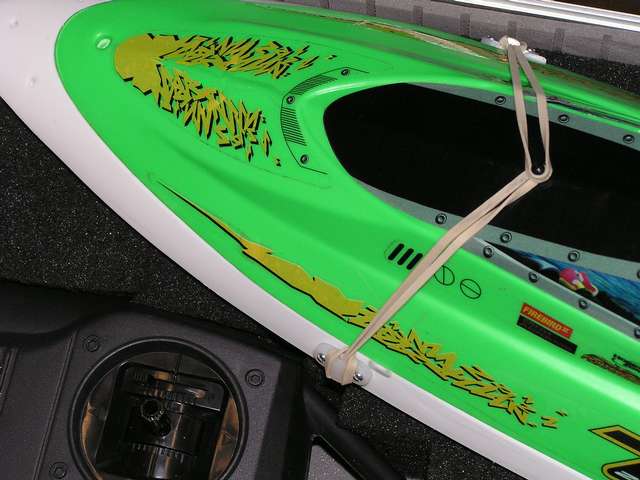 whole retrieval system inside a standard radio case
(or tool case). This makes for a very portable system that you can transport to
the pond very easily. Inside the case I can fit the radio, boat, several
batteries, the fishing reel, charger, and spare retrieve ball.
whole retrieval system inside a standard radio case
(or tool case). This makes for a very portable system that you can transport to
the pond very easily. Inside the case I can fit the radio, boat, several
batteries, the fishing reel, charger, and spare retrieve ball.
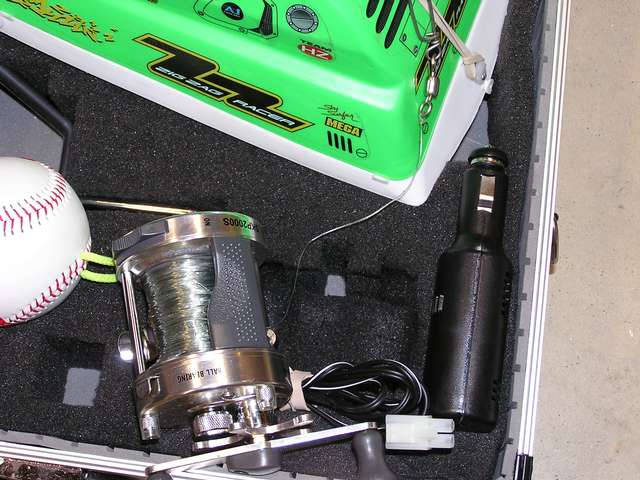 A hook was added to the back of the Zig Zag
boat so it is easy to clip on the fishing line. The soft rubber baseball is
useful when the stalled boat is only a short distance from the shore. It's easy
to move the fishing line clip to the baseball for a few quick tosses to pull the
stalled boat in. I'm also using a large bait casting fishing reel to hold 30
pound test line. This type of reel is desirable since it does not twist the line
when reeling it in.
A hook was added to the back of the Zig Zag
boat so it is easy to clip on the fishing line. The soft rubber baseball is
useful when the stalled boat is only a short distance from the shore. It's easy
to move the fishing line clip to the baseball for a few quick tosses to pull the
stalled boat in. I'm also using a large bait casting fishing reel to hold 30
pound test line. This type of reel is desirable since it does not twist the line
when reeling it in.
This
system has proven to work very well. It's been used to retrieve a lot of stalled
boats, even boat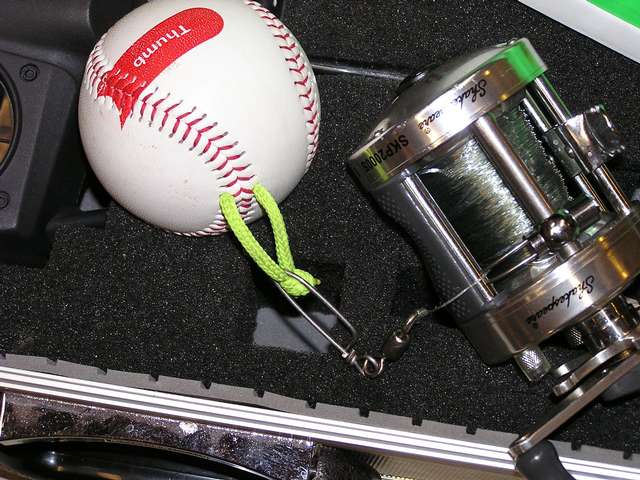 s
stuck on the far shore of the pond! There are, though, a couple of situations
where this retrieve system won't work well. If the boat is dead in the water and
only the bow of the hull is sticking out of the water, it can be tricky to
retrieve the boat. It may help to put a little weight on the line a couple of
feet behind the boat to try and hook the rudder. If the stalled boat is upside
down, this system still works by dragging the fishing line over the boat and
then grabbing the rudder or prop. In any retrieve, though, you must be careful
when catching the boat as rudders and props are often very sharp and it is
possible to cut the fishing line. This can be remedied by using a steel leader
or fly fishing line at the tip, which can be more durable.
s
stuck on the far shore of the pond! There are, though, a couple of situations
where this retrieve system won't work well. If the boat is dead in the water and
only the bow of the hull is sticking out of the water, it can be tricky to
retrieve the boat. It may help to put a little weight on the line a couple of
feet behind the boat to try and hook the rudder. If the stalled boat is upside
down, this system still works by dragging the fishing line over the boat and
then grabbing the rudder or prop. In any retrieve, though, you must be careful
when catching the boat as rudders and props are often very sharp and it is
possible to cut the fishing line. This can be remedied by using a steel leader
or fly fishing line at the tip, which can be more durable.
For a modest investment, you can have a highly portable, very reliable boat retrieval system that can be almost as fun using as driving your big gas boat!
Parts:
- Zig Zag racer - $80* (www.horizonhobby.com )or check your local hobby store)
- Fishing reel and line - $45 (Walmart)
- Tool case - $20 (Lowes, Home Depot, Harbor Freight or local hardware store)
- Having a good time even when your boat is dead in the water - priceless!
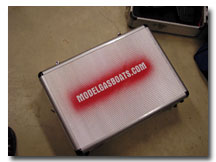
* A new model, called Zig Zag 2 was just released. This means you can often get the older model at a steep discount. I've heard some hobby stores are selling the old Zig Zag racers for nearly 50% off.
UPDATE (6/23/04):
Brian Madigan (bmad01 on Jim's RC Boat Dock) made a great suggestion about mounting the reel on the transmitter. I liked it so much I immediately modified my setup to incorporate his idea. Here are some pictures of the result:
I started by riveting two small 3/4" aluminum angle pieces to the back of the transmitter. I then bent a 3/4" aluminum strip to match up with the transmitter brackets. The reel is riveted to the large "C" bracket. Holes were drilled to allow a 3/16" rod to be used as a connector. I originally had tapped the holes on the transmitter bracket and used thumb screws, but I wanted something that allowed the reel to be removed more easily. So now all I have to do is pull out one of the retainer clips and slide the connector rod out to quickly remove the reel. Thanks for the idea, Brian!
